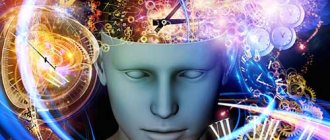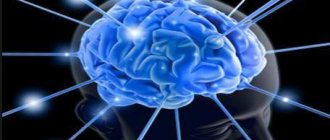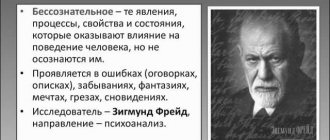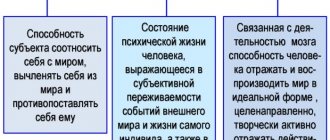Consciousness as the highest form of psyche
The main feature of the human psyche is that, in addition to hereditary and personally acquired forms of behavior, a person possesses a fundamentally new, most important means of orientation in the surrounding reality - knowledge, which represents the concentrated experience of humanity, transmitted through speech. “Consciousness” literally means “the body of knowledge.” The human psyche is formed and constantly enriched in the conditions of the social environment, in the process of assimilating social and public experience. If an animal raised in artificial, isolated conditions retains all its species qualities, then a person without a social environment does not acquire any human qualities.
Theoretical foundations of consciousness
Modern psychologist I. Tulving studied and presented the theoretical foundations of consciousness:
- Anoetic consciousness
(procedural memory) is a state where we are not conscious of anything, but we register environmental cues and respond to them.
- Noetic consciousness
(semantic memory) is a state when we are aware of something that is not part of the existing environment, like symbolic consciousness.
- Autonoetic consciousness
(episodic memory) is what we know about ourselves, the memory of events in our personal life.
Previously, philosophers and psychoanalysts studied consciousness, but Tulving scientifically substantiated his classification and experimentally confirmed it.
The origin of consciousness in evolution
In the history of science, about 40 cases have been described in which children were fed animals from an early age. They did not show not only signs of consciousness (they completely lacked speech and thinking), but even such a physical property of a person as the vertical position of the body when walking. With the transition from animal existence to human society, two new factors in the formation of the human psyche arose: social labor, the use of tools and communication through words. With the advent of upright walking, a person’s hand was freed, his horizons expanded, and conditions arose for the intensive development of his orienting activity. This led to the emergence of tools and the labor process. A person begins to live in a world of permanent tools of labor, through which labor operations are transmitted from generation to generation. Making the simplest tool inevitably requires such conscious actions as a preliminary idea of its functions, shape, and material properties. Actions to manufacture a weapon must be planned in a certain order. They must be realized and remembered for its re-production. The production of tools is associated with the mental division of the whole into parts (analysis), with the isolation (abstraction) of individual properties of an object, as well as with the mental unification (synthesis) of isolated properties into imaginable integral tools. The improvement of labor processes and the production of more and more complex tools was associated with the improvement of the analytical and synthetic activity of the human cerebral cortex; The instrument of this activity—speech—was also improved. The social organization of work activity has led to the identification of individual actions that acquire meaning only through the work of other people. Thus, in work, conscious actions arise, divorced from the immediate biological goal, and a person’s abstract thinking and will are formed.
Brain research, functional asymmetry
The next stage in the study of consciousness is brain research. Let us consider, for example, what contribution the functional asymmetry of the brain makes to the functioning of the neural mechanisms of vision, which plays an important role in attention processes. The left and right hemispheres play different roles in perception and image formation.
The right hemisphere is characterized by high speed of recognition, its accuracy and clarity. It most likely compares the image with some standards available in memory on the basis of identifying similar informative features in the perceived object.
The left hemisphere carries out a mainly analytical approach to image formation, associated with the sequential selection of its elements according to a certain program. However, if the left hemisphere works in isolation, then it will not be able to integrate the perceived and selected elements into a holistic image. With its help, phenomena are classified and assigned to a specific category through the designation of a word. Thus, both hemispheres of the brain simultaneously take part in any psychological process.
Functional asymmetry of the brain led scientists to believe that there are two types of consciousness: spatial knowledge in the right hemisphere, and language knowledge in the left hemisphere. This assumption has led to a large number of studies and classifications of levels of consciousness.
Each sensory modality has its own levels of consciousness. Sensations from each level enter the cognitive system, but we are not aware of them until we direct our attention to them.
From this we can conclude that we can easily control our consciousness, but, alas, due to the fact that it operates at different levels, this is not easy to do. There are, as it were, two levels of information availability: easy and difficult to access.
Easily accessible information is quickly transferred from the preconscious memory to the conscious one, while difficult-to-access information, being in the subconscious memory, may not transfer to the conscious one. It is possible that this approach is quite controversial, but one thing is clear: the study of consciousness is very important for the study of attention and memory.
Formation of consciousness in ontogenesis
In the process of formation of the human psyche, his external physical actions with material objects precede the formation of internal mental actions. Only on the basis of action with material objects does a person gradually move on to operating with their ideal images, to actions in the mind. This transition from external actions to internal actions is called internalization (“turning into internal”). Thanks to the ability to act with mental, ideal images of objects, a person begins to model various relationships between objects and anticipate the results of his actions. Interiorization is carried out on a verbal, speech basis. The word is used both as a means of designating objects and as a symbol of their general, essential properties. Having been formed on the basis of external actions, mental actions themselves begin to regulate external actions. All conscious actions of a person are an exteriorization (external manifestation) of his internal mental activity.
Consciousness and self-awareness
An essential feature of human consciousness is self-awareness. By realizing the objects of his activity and his relationships with other people, a person begins to become aware of himself, to distinguish himself, his Self from the world around him. The content of self-awareness is a person’s awareness of his physical and mental properties, his actions and actions, feelings and aspirations. Separating himself from objective reality, realizing his advantages and disadvantages, a person begins to change his psyche, his behavior in accordance with the requirements that society places on him and the goals that he sets for himself in the process of self-education. Self-awareness is manifested in self-observation, critical attitude towards oneself, self-control and responsibility to society for one’s actions and actions. A certain level of self-awareness is a necessary prerequisite for lawful behavior. Self-awareness is a holistic, integrative, conceptual reflection by a person of his own personality, it is a mental model of his Self. A person directs and regulates his activities based on his Self-concept, which is determined by the social conditions of the individual’s existence, his social identification (assigning himself to a certain social group) . Self-awareness is a socially conditioned attitudinal system of a personality, a system of its value-semantic formations. On this basis, all human behavioral acts are carried out; they acquire personal unity - the style of behavior of a given individual.
Philosophy: lecture notes
Lecture No. 11. Consciousness
Consciousness
as a philosophical term - the highest, uniquely human form of reflection of objective reality.
Consciousness
is a set of mental processes that are actively involved in a person’s understanding of the objective world and his own existence. It arises in the process of labor, social and production activity of people and is inextricably linked with language, as ancient as consciousness.
From birth, a person enters the world of objects created by the hands of his ancestors, and is formed as such only in the process of learning how to use them. A person’s way of relating to reality is determined not by his bodily organization (as in animals), but by the skills of objective actions acquired through communication with other people. By mastering historically developed methods of objective activity, especially language, a person receives objective knowledge about the properties of objects in the world. A person stands out and opposes himself to objective reality thanks to purposeful actions, that is, his active life is guided by ideas or knowledge about the real properties of objects. It is precisely because a person treats objects with understanding, with knowledge, that his way of relating to the world is called consciousness.
Without understanding and knowledge, which socio-historical objective activity and human speech bring with them, there is no consciousness. Any sensory image of an object, any sensation or idea is part of consciousness insofar as it has a certain meaning in the system of knowledge acquired through social activity. Knowledge stored in language directs and differentiates a person’s feelings, will, attention and other mental acts, uniting them into a single consciousness. The knowledge accumulated by history, political and legal ideas, artistic achievements, morality, religion and social psychology represent the consciousness of society as a whole. However, consciousness cannot be identified only with logical thinking. Outside of sensory-volitional, active activity, the entire sphere of mental thinking does not exist at all. If a person only carried out logical operations one after another, but in practice did not sense, feel, or experience the constant correlation of the meaning of his concepts with active actions and perceptions of reality, then he would not understand and be aware of neither reality nor himself, that is, it would have neither consciousness nor self-awareness. However, the concepts of “psyche” and “consciousness” cannot be identified, i.e., one cannot assume that all mental processes in a person are included in consciousness at any given moment. A number of mental experiences may remain for a certain time, as it were, beyond the threshold of consciousness. Consciousness, absorbing historical experience, knowledge and methods of thinking developed by previous history, masters reality ideally, setting new goals and objectives, creating a project for future tools, directing all practical human activities.
Essential Features of Consciousness
The human psyche and consciousness is a system of mental self-regulation based on socially formed categories and value orientations. Human consciousness as the highest form of mental development has the following essential features: 1. Categoricality - a reflection of the world through the prism of universal human knowledge and positions, a reflection of the world on the basis of a conceptual scheme. 2. Reflection of significant, most significant relationships in a given situation. 3. Awareness of the goals of activity, anticipation of them in the system of universal human concepts and ideas. 4. The conditioning of individual consciousness by social forms of consciousness. 5. Self-awareness is a conceptual model of one’s own personality and the construction of interactions with reality on this basis. All essential aspects of consciousness function with the direct participation of speech.






